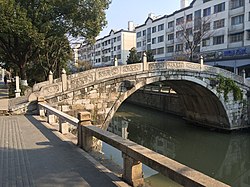Taicang
|
Taicang 太仓市 |
|
|---|---|
| County-level city | |
 |
|
| Location in Jiangsu | |
| Coordinates: 31°33′50″N 121°10′26″E / 31.564°N 121.174°ECoordinates: 31°33′50″N 121°10′26″E / 31.564°N 121.174°E | |
| Country | People's Republic of China |
| Province | Jiangsu |
| Prefecture-level city | Suzhou |
| Municipal seat | Chengxiang (城厢镇) |
| Divisions | 7 towns: Chengxiang, Shaxi, Ludu, Liuhe, Fuqiao, Huangjing, Shuangfeng |
| Area | |
| • Total | 642 km2 (248 sq mi) |
| Population (2011) | |
| • Total | 947,000 |
| • Density | 1,500/km2 (3,800/sq mi) |
| Time zone | China Standard (UTC+8) |
| Postal code | 215400 |
| Area code(s) | 0512 |
Taicang (Chinese: t , s , p Tàicāng, [tʰâi̯ tsʰáŋ], Wu Tha去 Saon平, lit. "Great Storehouse") is a county-level city under the jurisdiction of Suzhou, Jiangsu province, bordering Shanghai to the northeast and east and the Jiangsu prefecture-level city of Nantong to the north across the Yangtze River. In 2008, the registered population was at 466,300, and total GDP reached RMB 52.8 billion (US$7.6 billion). The GDP per capita reached RMB 79,449 (US$11,439). Taicang has been consistently ranked in top 10 of the National Bureau of Statistics' 100 Most Competitive County Level Cities in China.
Taicang administers seven towns:
The city traces its roots back to the 3rd-century Three Kingdoms era, when Eastern Wu build storage facilities for agriculture products in this area.
Taicang is a natural port. Under the Yuan, the city reached its peak between 1271 and 1368. Under the Ming, Taicang's Liuhe Harbor was the departure point for Zheng He's treasure fleets. It was also during this period that the shoals in the Yangtze estuary which later became Chongming Island were placed under the supervision of Taicang Prefecture.
...
Wikipedia

